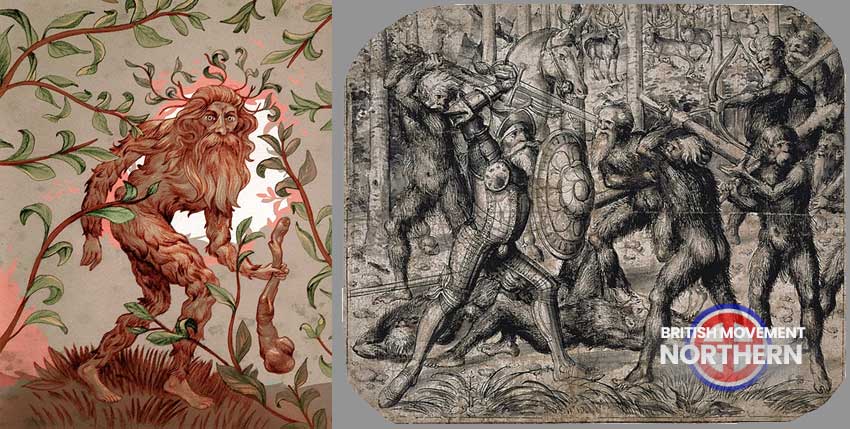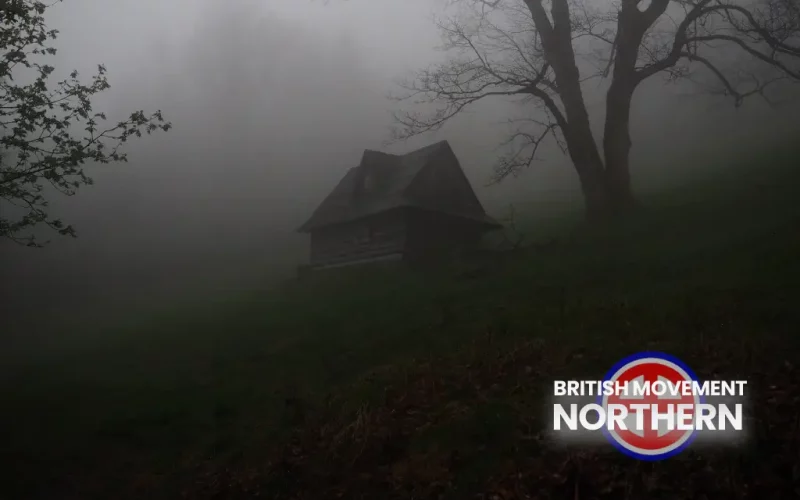“The traditions, values, and beliefs held by previous generations create an indelible impact on how we view our place in the world. Knowing our peoples’ history and culture helps us construct our identity and build a sense of pride around being part of the White race.”
The Woodwose – The Wildmen Of The Forests And Moors.
The dense forests of Britain were seen as something dark and disturbing, often impassable due to thick brambles and under-growth. Wolves and bears still roamed. They were the domain of thieves and criminals hiding from the law and even worse, they were widely believed to be haunted by all sorts of monsters and wild beings.
In medieval and early-modern times, wildmen known as Woodwose, the “wuduwasa” or “wood man” were said to inhabit the forests and moorlands across the island of Britain. Although relatively unknown nowadays, tales of the Woodwose are buried deep in the mythology, legend and folklore of Medieval Europe. The figure of the Woodwose was used on coats-of-arms and illuminations during the Middle Ages up to the Renaissance. A folk-memory that is not shared by the millions of new-comers to our land since 1948.
Woodwoses are often pictured bearing a club, to symbolise the savage aspect of man, and are often accompanied by images of the “Green Man”, a humanoid character covered in greenery. The woodwose is similar to Bigfoot, a bipedal, hairy hominoid creature rumoured to dwell most commonly in forest regions. It is believed that the Bigfoot legend was taken to America by European settlers.
The woodwose is thought to have been inspired by gods featured in ancient mythology, such as Silvanus, the Roman god of the countryside; Maia, the Greco-Roman goddess of fertility and the earth; and Orcus, the Roman and Italian god of death.
In popular culture, JRR Tolkien’s legendarium references* the woodwose, sometimes shortened to “Wooses” or “Drúedain.” According to the legendarium, woodwoses were mistaken for goblins and other forest-dwelling creatures by the Rohirrim, and thus named Púkel-men (Goblin-men).
In the famous late 14th century poem Sir Gawain And The Green Knight, Sir Gawain travels to find the Green Chapel and encounters several mythical and real beasts including the wildmen of the wood. The word wodwos appears, which many centuries later the author J.R.R. Tolkien translated as “wood-trolls”.
“Sometimes he fights with dragons and sometimes with fierce wolves
Sometimes with wodwos that haunted the mountains
Both with bulls and bears and occasionally a boar
And giants chased him through the fells”
Tolkien, author of the Lord Of The Rings and many other books about Middle Earth arrived in Leeds in the autumn of 1920, aged 28, joining the University of Leeds as a Reader in English Language before being promoted to Professor within a few years.
Whilst at Leeds University he cannot have failed to notice the name of the road on which the university is situated, Woodhouse Lane, a road named after the Woodwose. By the time he left in 1925 he had established the School as a UK leader in Old Icelandic language and literature.
In his book, The Children of Hurin, when the hapless Turin is staying in Doriath he is taunted by an Elf named Saeros and Turin hurls a drinking vessel at him. Then Saeros says:
“How long shall we harbour this woodwose? Who rules here tonight? the King’s law is heavy upon those who hurt his liegers in the hall…. outside the hall I can answer you, Woodwose!” (The Children of Hurin, p.88)

Tolkien’s Middle Earth
The Druedain was a race of wild Men. The Rohirrim called them Woses or Wild Men of the Woods. In The Lord of the Rings, they assist the Riders of Rohan to avoid ambush on the way to the Battle of the Pelennor Fields.
The Druedain lived in the Druadan Forest in huts, tents, and in small tribes. They did not fight for any side, but they hated Sauron. In the First Age, the Druedain guarded the Forests of Beleriand. Towards the end of the Third Age, their Chief, Ghan-Buri-Ghan led the Rohirrim to The Battle of Pelnnor Fields through Druedain Forest. In exchange for his help, Ghan-Buri-Ghan made the Rohirrim promise never to hunt them as animals, as the Rohirrim did in ancient days. Before disapearing into the woods forever, Ghan-Buri-Ghan said “The wind is changing.” This probably means there was still hope for the West.
Why We Need To Remember Our Folk Heroes
A few years ago the British Social Attitudes polling organisation asked members of the public what defined ‘Britishness’. 51% of those questioned said descent and ancestry were the main factors. Only 32% of those who took part regarded civic conceptions of national identity the main factor, whilst 61% believed that civic and ethnic conceptions combined were what made somebody British.
“Those who think national identity has at least some ethnic element are more likely to be opposed to immigration”.
*Tolkien’s legendarium is the body of J. R. R. Tolkien’s mythopoeic writing, unpublished in his lifetime, that forms the background to his The Lord of the Rings, and which his son Christopher summarized in his compilation of The Silmarillion and documented in his 12-volume series The History of Middle-earth. Wikipedia.
Resources:
Top Image: Cabin In The Woods – Free to use under the Unsplash License.
Other Images: Public Domain.
The British Movement welcomes articles for possible inclusion on this site from members and supporters across the North of England. Please remember that we have to operate within the laws of this country – we will not include any content that is against the current laws of the United Kingdom. News reports should be topical and be relevant to the regions covered by this website.












